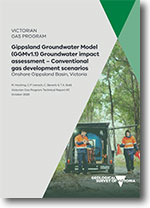VGP Technical Report 40 - Groundwater impact assessment – Conventional gas development scenarios Onshore Gippsland Basin, Victoria.
 |
| |||||
Product description:About the Victorian Gas Program: The Victorian Gas Program (VGP) is a comprehensive science-led program, incorporating geoscientific and environmental research to assess the risks, benefits and impacts of potential onshore conventional gas exploration and production. The program is also investigating the potential for further discoveries of onshore conventional and offshore gas in the Otway and Gippsland geological basins and assessing the feasibility of additional onshore underground gas storage in depleted reservoirs around the Port Campbell area. The VGP includes an extensive, proactive and phased community and stakeholder engagement program, through which the results of the scientific studies are being communicated. Executive summary: Predicted regional impacts on groundwater levels of onshore conventional gas have been assessed in the Gippsland Basin as part of the Victorian Gas Program (VGP). A re-calibrated regional scale groundwater model has considered combinations of future gas developments to simulate the potential impacts that hypothetical onshore conventional gas development may have on groundwater in the Gippsland Basin. As part of the VGP environmental studies program, the Geological Survey of Victoria (GSV) has re-calibrated a Gippsland groundwater model from the Victorian Water Science Studies (VWSS) program (developed in 2015) to quantify groundwater impacts of hypothetical onshore conventional gas developments in the Gippsland Basin. The model was required to quantify individual and cumulative environmental impacts, including changes in the watertable, groundwater pressures, and changes to river baseflows. This Gippsland groundwater model was revised in two stages:
This report presents the second stage: the results of model scenarios to simulate any impacts of onshore conventional gas development in the Gippsland Basin. The Gippsland Basin, particularly the Latrobe Valley, has a long history of groundwater pumping for industrial, domestic and agricultural groundwater use that dates prior to the 1960s. As such, there is generally good understanding of the hydrogeology of the Gippsland Basin at a regional scale. The local geology at the Latrobe Valley Coal Mines (Yallourn, Hazelwood and Loy Yang) is well understood due to the many studies that have been conducted to map the extent and thickness of the various coal seams. Overall, the aquifers and aquitards are generally well mapped at a regional scale, despite there being some areas where additional detail would be beneficial. Gas development phases were simulated under transient (time varying) conditions to determine groundwater level changes within the life of the hypothetical gas developments. Simulations were extended decades beyond the life of proposed gas production until groundwater levels recover. The results suggest that there would be some small groundwater depressurisation effects on overlying water resource aquifers as a result of onshore conventional gas extraction. These groundwater drawdowns would primarily impact the Upper Latrobe Group, with negligible impacts in the overlying Boisdale Formation and no impacts in the watertable aquifer. Time to initial groundwater level decline of the low and medium production scenarios was around 0.5 to 1.5 years, with the high production scenario predicting initial impact within three years of commencement of gas production. Time to total groundwater recovery in the water resource aquifers was generally between 5 and 30 years, depending on the production scenario (low, medium or high volume) and scenario location (Sites 1–7). Bibliographic reference: HOCKING, M., IVERACH, C.P, BEVERLY, C. & BOLD, T.A., 2020. Gippsland Groundwater Model (GGM v1.1) Groundwater impact assessment – Conventional gas development scenarios, Onshore Gippsland Basin, Victoria. Victorian Gas Program Technical Report 40. Geological Survey of Victoria. Download: The downloadable version of this report is supplied in PDF format (PDF 14 MB). | ||||||

